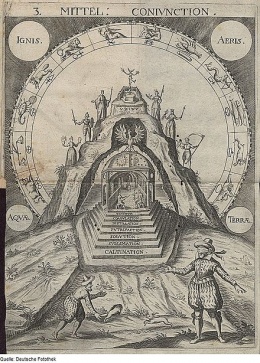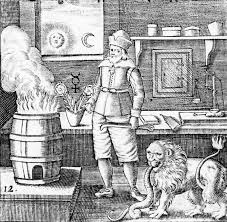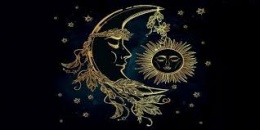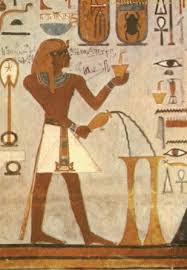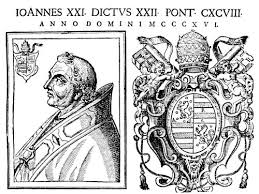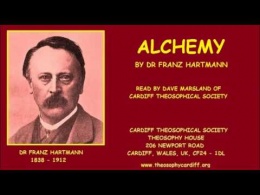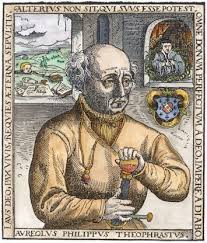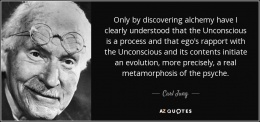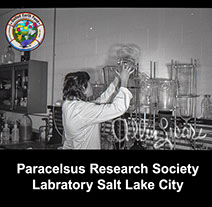Alchemy
Alchemy is a science which seeks to convert one species of metal into another, namely base metals into noble metals, especially gold. The Philosopher’s Stone is the legendary substance needed for this process and one of the two key things sought after by Alchemists. The other being the Elixir of Life, the potion thought to prolong life indefinitely.
The transmutation of metals and the fabrication of gold was the material aspect of alchemy. Along with it there is Spiritual Alchemy, the Alchemy of the Soul in Man, meaning the transmutation of the animal nature into the Higher Self, man's inner Ego, and its reabsorption into the Universal or World-Soul.
Alchemy has a history stretching back for at least two thousand years and has been practiced in Eastern, Arabic, and Western societies. It has attracted many types of people with widely differing motivations.
The immediate derivation of the word alchemy is from the Arabic al kimia. Al means “the”, but the meaning of the second word is not quite clear. Some scholars believe that it is associated with the Egyptian word chem, signifying “black” and relating to the description of Egypt as “The Land of the Black Soil”. Other scholars consider it more likely that the word is derived from chymia, a Greek word relating to the casting of fusion of metal. [1]
What is Alchemy
Among all the known secret sciences alchemy is probably the most veiled and at the same time the most misunderstood discipline. For most people alchemy was nothing more but the dubious sensation of making gold and the elixir of life. [2]
Today most scholars see alchemy of a twofold nature, an outward or exoteric, and hidden or esoteric. Exoteric alchemy is concerned with attempts to prepare a substance, the philosopher’s stone endowed with the power of transmuting the base metals led, tin, copper, iron, and mercury into the precious metals gold and silver. The elixir is credited with the power of prolonging human life indefinitely. However, the belief that it could be only obtained by divine grace led to the development of esoteric or mystical alchemy and this gradually developed into a devotional system where the mundane transformation of metals became merely symbolic of the transformation of sinful man into a perfect being through prayer and submission to the will of God. [3]
The alchemical operation works on three levels of being at once – on body, soul, and spirit. The hermetic philosophy maintains that everything – animal, vegetable, and mineral – contains these three elements, but in an unawakened form. The Great Work breaks down the existing relationship between them, activating each separately, and leading them from an ignorant and inert state to perfection. Alchemists initiate this operation both in the materials they work with in their laboratories and in their own individual being. They aim to free the soul and spirit of matter and to reunite them with the body in a new and exalted form; they also fulfill this task in their own lives. Prayer, observation, and work are the tools they use to activate their own spiritual, psychological, and physical faculties. [4]
The Magnus Opum), an alchemical term for the process of working with the prima materia to create the philosopher's stone can, according to Hermetic tradition, only happens when the neophyte of alchemy gains access to the spiritual power in himself based on specific methods. He has to follow a strict kind of Kabbalistic yoga. He has to contemplate metaphysically the laws of nature and the natural phenomena in physics and chemistry. During his meditations he is striving to experience nature and to look for analogies within himself to connect the phenomena of the outer and inner world. This happens when he becomes one with the object of his meditation, whereby he penetrates the various realms of nature, minerals, the vegetable and animal kingdom, geology, and the inner essences of terrestrial appearances. To ease the hermetical meditation the adepts compiled charts but only those who received training were able to read the hermetic symbols. [5]
According to Manly Hall, alchemy is actually a dedicated effort to find out where we come from, why we are here, and where we are going. It is also a science by which all sciences built in selfishness can be re-dedicated to the common good of humanity. It is a way of applying all that we know to all the problems that we must solve. Step by step, we become more knowing, more useful, and more helpful, becoming better citizens here and, whether we realize it or not, better citizens of Eternity. [6]
History of Alchemy
There is some doubt concerning the earliest mention of alchemy; it might have been in the Chinese edict of 144 B.C. or a book written in Egypt around 200 B.C. but the main line of development of alchemy began in Hellenistic Egypt, and particularly in Alexandria. [7]
It is thought to have originated there over 2000 years ago, the result of three converging streams: Greek philosophy, Egyptian technology and the mysticism of Middle Eastern religions. Its heyday was from about 800 A.D. to the middle of the seventeenth century, and its practitioners ranged from kings, popes, and emperors to minor clergy, parish clerks, smiths, dyers, and tinkers. Even such accomplished men as Roger Bacon, Thomas Aquinas, Sir Thomas Browne and Isaac Newton took an interest in alchemical matters. In its search for the "Philosopher's Stone" that would transmute base metals into silver and gold, alchemy took on many philosophical, religious and mystical overtones.
[8]
By the end of the seventeenth century a new chemistry had begun to take shape, in which the basic conceptions and theories of alchemy had no part. The founder of this system was the Hon. Robert Boyle (1627 - 91) who struck at the root of all alchemical speculation by denying that the four Aristotelian “elements” had any right whatever to that description in his book Skeptical Chymist which was the warrant for alchemy. [9]
Alchemists had always had different motives widely. Some were out-and-out materialists, greedy to try and make themselves rich by mastering the secret of creating gold. Some were merely gullible, others fraudulent, performing fake transmutations and getting their gold from the pockets of their spectators and prospective pupils rather than through any success in the laboratory. Even among the sincere and dedicated alchemists, the emphasis of approach could be very different. Some were more interested in the chemical techniques of alchemy, others in the philosophical aspects. Some saw alchemy as a path to the true meaning of Christianity, while others saw in it possibilities for producing subtle and potent medicines. [10]
In Europe many alchemists were persecuted and often tortured and put to death because the rulers wanted the secret of gold making. [11] In other cases, alchemy was forbidden. For example, Pope John XII issued the bull Spondent partier, which forbade alchemy and accused the alchemists of deception. Those caught manufacturing alchemical gold, the bull decreed, would be compelled to give to the poor an amount of true gold equal to that which they had made and if they couldn’t pay, they would be imprisoned. In this climate, practicing alchemy was dangerous and the Italian alchemist Cecco d’Ascoli was burned at the stake by the Inquisition in Florence in 1327. [12]
Theosophical View of Alchemy
According to Helena Petrovna Blavatsky, before Alchemy existed as a science, its quintessence alone acted in nature's correlations and in all its planes. When there appeared on earth men endowed with a superior intelligence, they allowed this supreme power to have full and uncontrolled action and from it they learnt their first lessons. All that they had to do was to imitate it. But in order to reproduce the same effects by an effort of individual will, they were obliged to develop in their human constitution a power called Kriyasaktiin occult phraseology.
This faculty is creative because it is the agent on an objective plane of the first creative principle. It resembles a lightning conductor in that it conducts and gives a definite direction to the creative quintessence which otherwise, if led blindly into the lower planes, kills; but which brought down through the channel of the human intellect creates according to a predetermined plan. From this Alchemy was born.
In the course of ages nations become more selfish and were convinced of their complete superiority. The development of Kriyasakti became more difficult and the divine faculty almost disappeared from the earth. Eventually, even the presence of a spirit and of a soul was rejected. Thus, we ended up with the science of modern chemistry.
In the end, only great initiates are able to correctly interpret the jargon of hermetic philosophers. And then again, since there exist more false than true hermetic writings, even those of Hermes himself may be found distorted. Thus, symbols taken as guides to the transmutation of metals, become of small value to those methods which we now call chemical.
[13]
According to Dr. Franz Hartmann, Theosophist and contemporary of H.P.B., everything in Nature has a threefold aspect and the highest aspect of alchemy is the regeneration of man in the spirit of God out of the material elements of his physical body. The physical body itself is the greatest of mysteries, because in it are contained in a condensed, solidified, and corporeal state the very essences which go to make up the substance of the spiritual man, and this is the secret of the “Philosopher’s Stone.” The sign in which the true alchemist works is the Cross, because man roots with his material elements in the earth, penetrates with his soul through the animal forces of Nature, while his higher nature reaches above the animal creation into the realm of immortality.
The next aspect of alchemy is the knowledge of the nature of the invisible elements, constituting the astral bodies of things. Each thing is a trinity having a body and a spirit held together by the soul, which is the cause and the law. Physical bodies are acted upon by physical matter; the elements of the soul are acted upon by the soul, and the conscious spirit of the enlightened guides and controls the action of matter and soul. By the power of the spirit material elements may be sublimated into invisible elements, or invisible substances be coagulated and become visible.
The lowest aspect of alchemy is the preparation, purification, and combination of physical substances, and from this science has grown the science of modern chemistry, which in its present state is a great advancement over the lower aspect of old chemistry, but which has lost sight entirely of the higher aspects of Nature. A higher advancement of the science of chemistry will bring it again into contact with alchemy. Chemistry decomposes and recombines material substances in certain proportions but leaves the primitive elements unchanged. Alchemy, however, changes the character of things, and raises them up into higher states of existence. To understand correctly the meaning of the word alchemy, it is necessary to understand the intimate relationship and the identity of the Microcosm and Macrocosm, and their mutual interaction. All the powers of the universe are potentially contained in man, and man’s physical body and all his organs are nothing else but products and representatives of the powers of Nature. [14]
Boris de Zirkoff explained, that the philosopher's stone, capable of transmuting metals, is the Higher Nature in man which transforms all base and lower instincts into the bright gold of purity and truth by means of that triple process of "fermentation, calcination, and transmutation," which stand for personal experience, suffering, and the ultimate knowledge of the Great Reality.
The Elixir of Life is the beverage of the Spirit. It steals in the silence into the soul of man. It quietly fills his mind, coming from the upper regions of the Inner Light. Like a ray of Divine Compassion, it illumines "the darkest corners of the earth" and warms the icy plains of indifference producing spiritual death. He who has grasped the inner meaning of the Riddle, and has transmitted in himself the animal nature into the Real Man, will know the ultimate goal of existence, and even in the midst of darkness, on the foaming crests of a stormy sea, will behold the Truth as it really is - Aletheia the Breath of the Great Unknown.
[15]
The Three Elements
“All things [man included] are composed out of three substances, and all things have their number, their weight, and their measure. Health exists when the three substances constituting a thing preserve their normal proportion of quantity and quality; disease results if this proportion becomes abnormal. These three substances are called Sulphur, Mercury, and Salt. [16]
Paracelsus himself said:
You should know that all seven metals originate from three materials, namely from mercury, sulfur, and salt, though with different colors. Therefore, Hermes has said not incorrectly that all seven metals are born and composed from three substances, similarly also the tinctures and philosopher’s stone. He calls these three substances spirit, soul, and body. But he has not indicated how this is to be understood and what he means by it. Although he may perhaps have known, yet he has not thought to say it. I therefore do not say that he has erred, but only kept silent. But that it be rightly understood what the three different substances are that he calls spirit, soul, and body, you should know that they mean no other than the three principia, that is mercury, sulphur, and salt, out of which all seven metals originate. Mercury is the spirit, sulphur is the soul, salt the body. But there are many kinds of each one! [17]
Thus, the alchemical terms are symbolical throughout, and unless the student acquires the key to their hidden meaning, he will not be able to understand the actual rationale of the process indicated by alchemists. It is interesting to note, however, that besides being a symbolical expression, mercury of the alchemists was in many cases actually the metal that was used by a number of them for the purpose of gold-making. This feat was accomplished by a large number of students of the art of alchemy, for which there exists abundant testimony, and acknowledgments on the part of honest, trusted, and trustworthy writers and thinkers. The fourteenth century teems with accounts on that subject. [18]
Most Famous Alchemists
The most famous of alchemical and Hermetic philosophers was Paracelsus(1493-1541).[19]
In the Archidoxa, Paracelsus offers a fresh vision for alchemy, one concerned not with gold making but with medicine. The book’s central premise is that, rather than trying to cure disease and illness by a spurious readjustment of the body’s humors through Galenic treatments such as bloodletting, the doctor can heal by harnessing the natural “virtues” of chemical remedies. The liberation of virtues, said Paracelsus, is achieved by the alchemical process of separation: a parting of the detritus and waste of mundane reality from the vital, healing forces of nature. This separation yields rarified, pure essences of nature. [20]
According to Paracelsus alchemy taught that the “heavenly substances are so perfect that they make other things perfect and “restore corrupted matter to purity”. He believed that such substances might be found and that they would restore health to the diseased body. As an alchemist, he was seeking the great nostrum which cures all evil, the fountain of youth which re-instills life into the exhausted flesh. As a chemist he distilled his “Azoth of the Red Lion [mercury, distilled from the mercury oxides]” and Mercurius Vivus. He claimed cures of cancer, syphilis, hydrophobia, epilepsy, and other incurable diseases through the Tinctura physicorum, and hinted that his Perlatum auti might preserve youth. [21][22]
Agrippa von Nettelsheim (1486-1535) dabbled like Paracelsus in alchemy and the occult sciences. [23]He studied with the legendary Trithemius of Sponheim and was long believed to set up a network of secret societies across Europe.[24]
To enable material substances to achieve perfection, certain pieces of laboratory gear are needed. Some of the most important of these devices were invented some time in the first century BCE by a Jewish alchemist in Alexandria, a woman named Miriam, called Mary the Jewessin later alchemical writings. [25]
Hermes Trismegistus, the legendary founder of western alchemy, is thought to have been a priest in Old Kingdom Egypt. The writings ascribed to him were later dated to the first centuries after Christ, although the wisdom contained may be much older. Huan Ti (2704-2595 BCE), is said to have been the founder of Chinese alchemy; Agastya is believed to have introduced alchemy to India, in addition to inventing the Tamil language and its grammar. Zosimos of Panopolis (c. 300) was a Hellenistic alchemist. Other famous alchemists mentioned often are Roger Bacon (c. 1214 – c. 1292), St. Thomas Aquinas (ca. 1225 – 1274), Nicholas Flamel (ca. 1330 - ?1417), Trithemius (1462-1516), Giordano Bruno (1548-1600), Jakob Boehme (1575-1624), a remarkable mystic who began as a follower of Paracelsus and his work emphasized alchemy as and entirely inner discipline. Others are Johann Valetin Andreae who was believed to be the author of the two Rosicrucian manifestos and The Chemical Wedding of Christian Rosenkreutz which uses specifically alchemical symbolismSir Isaac Newton (1642-1727) whose many writings on alchemy survived, the Comte de St. Germain (d. ?1784), a mysterious figure who has never been seen eating and has been seen several times since 1784, among others by Madame Blavatsky in India, and who was reported to possess the secret of transmutation; Cagliostro (1743-1795) who was rumored to have sold his soul to the devil and performed a successful transmutation in a Lodge in Warsaw on June 7th, 1780. Frater Albertus(1911-1984) is one of the leasing figures in the twentieth century practical alchemy and founded the highly influential Paracelsus Society workshop in Salt Lake City.[26]
Alchemy in the Twentieth Century
In the field of psychology, alchemy has found a natural home. With the growing urge to explore human instincts and mental processes, it became apparent that the alchemical process could be seen as a description of inner transformation. [27]
Carl Jung’s interest in alchemy began after having a dream in which he saw that his house had another wing that he had never noticed before. He eventually discovered in the house a magnificent library with books from the fifteenth and sixteenth century which contained alchemical diagrams and texts. Thus, he began studying alchemical books and came to believe that the alchemist was not so much trying to create precious metal from base in the laboratory but that the work of the opus magnum was psychological. He became convinced that the nigredo, or initial black, chaotic stage of the work was, in fact, the unconscious. [28]He pursued the connection between the unconscious and the occult and found examples of ancient mystical and occult symbols in the dreams of people who had never encountered those symbols in waking life. He came to believe that below the repressed memories of individual life, there exists a collective unconscious full of archaic images that appear in myths, legends, and the traditions of occultism. By bringing those images into consciousness, it is possible to achieve individuation, the psychological process that marks the growth of a personality into a balanced maturity. [29] Sterling, N.Y. 2017, page 161</ref>
But even before Jung, Major-General E.A. Hitchcock (1798-1870), an American, scorned the idea that transmutation of metals was the true aim of alchemy, holding instead that the object of the art was the perfection, or at least the improvement, of man. [30]
The place of alchemy in modern science is hardly a prominent one. However, both the revival of interest in alchemy as a practical occult discipling and the advances of the scientific world view meant that it retains a foothold there. Still, alchemy is feeding the general culture of the Western world. And some see the spirit of alchemy in other disciplines. [31]
Some schools of yoga for example talk about the alchemical body explaining that the bliss is located within, in the deepest part of our soul and that in order to connect to our bliss within we have to realign the energetic body, which carries prana, the life principle everywhere. This energetic system is composed of many channels that carry prana throughout the body to every part of us. If any of these channels are blocked, energy doesn’t flow properly and can create tightness, chronic pain, disease, mental stress, and anxiety. Thus, the alchemical process of yoga represents a significant inward turn for us. [32]
Albert Reidel (1911-1984) was born in Dresden Germany and was always interested in alchemy. As the clouds of war gathered over Europe he immigrated to the U.S. and became interested in Rosicrucianism. In 1960 he founded the Paracelsus Research Society (PRS) in Salt Lake City – later renamed Paracelsus College - and called himself Frater Albertus. Based on the Paracelsian concept of three essentials, Body, Soul and Spirit, Frater Albertus developed a system of teaching alchemical concepts using the spagyric technique of separation and cohobation. The unique graduated courses allowed students to explore aspects of the vegetable, mineral, and animal kingdoms in an understandable and accessible way. After his death in 1984, the college ceased operations in the U.S but continued to carry on the tradition in Australia. [33] Sterling, N.Y. 2017, page 191</ref>

Alchemy was a philosophical tradition whose goals were the creation of the philosopher's stone; the ability to transmute base metals into the noble metals (gold or silver); and development of an elixir of life, which would confer youth and longevity.
Mme. Blavatsky stated:
The transmutation spoken of by the real alchemists was the alteration of the base alloy in man's nature. At the same time, actual transmutation of lead into gold is possible. And many followers of the alchemists, as well as of the pure-souled Jacob Boehme, eagerly sought to accomplish the material transmuting, being led away by the glitter of wealth. . . . The stories told of various men who are said to have produced gold from base metals for different kings in Europe are wrong explanations.[34]
See also
Notes
- ↑ Gilchrist, Cherry. Explore Alchemy1984. Heart of Albion Press. Loughborough, LE, UK, page 1
- ↑ Szepes, Maria; Charon W. Academia Occulta. Die geheimen Lehren des Abendlandes. 2001. Wiener Verlag, Himberg/Austria. Page 81-82.
- ↑ Holmyard, E.G.Alchemy. Chapter I, Introduction. https://www.hoopladigital.com/title/11604698 Accessed on 8/8/19 through ehoopla
- ↑ Gilchrist, Cherry. Explore Alchemy. 1984. Heart of Albion Press. Loughborough, LE, UK, page 103-104
- ↑ Szepes, Maria; Charon W. Academia Occulta. Die geheimen Lehren des Abendlandes. 2001. Wiener Verlag, Himberg/Austria. Page 83 and 98.
- ↑ Hall, Manly. Esoteric Alchemy: Transmutation of Attitudes.. Lecture # 322. The Philosophical Research Society, 1986. https://archive.org/stream/302485469ManlyPHallEsotericAlchemy/302485469-Manly-P-Hall-Esoteric-Alchemy_djvu.txt. Accessed on 10/3/19.
- ↑ Holmyard, E.G.Alchemy. Chapter I, Introduction. https://www.hoopladigital.com/title/11604698 Accessed on 8/8/19 through ehoopla
- ↑ Holmyard, E.G.Alchemy. Chapter I, Introduction. https://www.hoopladigital.com/title/11604698 Accessed on 8/8/19 through ehoopla
- ↑ Holmyard, E.G. Alchemy. Chapter 8, Paracelsus. https://www.hoopladigital.com/title/11604698 Accessed on 8/12/19 through ehoopla
- ↑ Gilchrist, Cherry. Explore Alchemy. Heart of Albion Press, Loughborough, LE. 1984, page 1
- ↑ Hall, Manly. Alchemy. Kindle edition.
- ↑ Ball, Phillips. The Devil’s Doctor. Paracelsus and the World of Renaissance Magic and Science. 2006 Farrar, Straus and Giroux, New York. Page 144
- ↑ Blavatsky, H.P. Alchemy in the Nineteenth Century. https://cdn.website-editor.net/e4d6563c50794969b714ab70457d9761/files/uploaded/Siftings_V4_A9a.pdf#. Accessed on 10/10/19
- ↑ Hartmann, Franz. Paracelsus. Chapter 8; pages 157 of 194; http://www.philaletheians.co.uk/study-notes/buddhas-and-initiates/paracelsus-by-franz-hartmann.pdf. Accessed on 10/10/19
- ↑ de Zirkoff, Boris. Where Alchemy and Science Meet.THEOSOPHIA. Volume IV, No. 3 (21) - September-October 1947.
- ↑ Hartmann, Franz. Paracelsus. Chapter 8; pages 157 of 194; http://www.philaletheians.co.uk/study-notes/buddhas-and-initiates/paracelsus-by-franz-hartmann.pdf. Accessed on 10/15/19
- ↑ Holmyard, E.G.Alchemy. Chapter 8, Paracelsus. https://www.hoopladigital.com/title/11604698 Accessed on 8/12/19 through ehoopla
- ↑ de Zirkoff, Boris. Where Alchemy and Science Meet.THEOSOPHIA. Volume IV, No. 3 (21) - September-October 1947.
- ↑ Hall, Manly. Alchemy. Kindle edition.
- ↑ Ball, Phillips. The Devil’s Doctor. Paracelsus and the World of Renaissance Magic and Science. 2006 Farrar, Straus and Giroux, New York. Page2 164-165
- ↑ Paracelsus. Magic into Science. Henry Schuman, New York. Page 125
- ↑ Huser, Vol. VI, p. 373;
- ↑ Pachter, M. Henry Paracelsus. Magic into Science. 1951 Henry Schuman, New York. Page 61
- ↑ Martin, Sean. Alchemy and Alchemists. 2001. Pocket Essentials, Harpenden, U.K. Page 121-122
- ↑ Greer, John Michael. The Occult Book.Sterling, N.Y. 2017, page 11
- ↑ Martin, Sean. Alchemy and Alchemists. 2001. Pocket Essentials, Harpenden, U.K. Page 108-147
- ↑ Gilchrist, Cherry. Explore Alchemy1984. Heart of Albion Press. Loughborough, LE, UK, page 150
- ↑ Martin, Sean. Alchemy and Alchemists. 2001. Pocket Essentials, Harpenden, U.K. Page 94
- ↑ Greer, John Michael. The Occult Book.
- ↑ Gilchrist, Cherry. Explore Alchemy1984. Heart of Albion Press. Loughborough, LE, UK, page 150
- ↑ Gilchrist, Cherry. Explore Alchemy1984. Heart of Albion Press. Loughborough, LE, UK, page 158
- ↑ Kaivalya, Alanna, PhD. Yoga, Beyond the Mat 2016. Llewellyn Publications, Woodybury, MN. Pages 93 – 101
- ↑ Greer, John Michael. The Occult Book.
- ↑ Helena Petrovna Blavatsky, Collected Writings vol. IX (Wheaton, IL: Theosophical Publishing House, 1974), 117.
Online resources
Articles
- Alchemy in the Nineteenth Century by H.P. Blavatsky
- The Science of Life by H. P. Blavatsky
- Where Alchemy and Science Meet by Boris de Zirkoff
- Best Books about Alchemy by Katinka Hesselink
- Homuncli, Golems, and Artificial Life by Gary Lachman
- Alchemy or the Hermetic Philosophy by Alexander Wilder
- Alchemy and the Alchemists at WisdomWorld.org
- Alchemy at Katinkahesselink.net
